It’s the 100th episode!!!!!! To mix things up, today we’re traveling to the 1919 to see how three different events shaped the last 100 years, and will continue to shape the future.
Guests:
- Cathleen D. Cahill, professor of history at Penn State University
- Adam Green, professor of history at the University of Chicago
- Virginia Scharff, professor of history at the University of New Mexico
Further Reading:
- Dr. Mabel Ping-Hua Lee
- For Mabel Lee, a pioneer for suffrage, some recognition at last
- LOVE LETTERS TO MOVEMENT LEADERS: MABEL PING-HUA LEE
- Carrie Williams Clifford
- Race Rhymes by Carrie Williams Clifford
- The Widening Light by Carrie Williams Clifford
- Marie Louise Bottineau Baldwin: Indigenizing the Federal Indian Service
- Who was Nina Otero Warren
- Challenging the whitewashed history of women’s suffrage
- The 19th Amendment Only Really Helped White Women
- Library of Congress: More to the Movement
- How a Brutal Race Riot Shaped Modern Chicago
- ‘Chicago 1919: Confronting the Race Riots’ looks to bring city to terms with a chilling summer 100 years ago
- Chicago’s Red Summer
- “The Negro in Chicago; a study of race relations and a race riot” (1922)
- 1919 by Eve Ewing
- A Few Red Drops: The Chicago Race Riot of 1919 by Claire Hartfield
- Red Summer: The Summer of 1919 and the Awakening of Black America by Cameron McWhirter
- How An Army Convoy Crossed America In 56 Days To Prove We Needed Better Roads
- Eisenhower Library Exhibit Showcases 1919 Transcontinental Convoy
Actors:
- Monica Byrne (motor convoy)
- Tamara Krinsky (suffrage)
- James T. Green (prohibition)
- Michael Resweber (Chicago riot)
Content Notes:
- [27:00 – 38:53]: Discussion of racism and hate crimes
Music Notes:
- Swing Low, Sweet Chariot — Tuskegee Institute Singers
- Baby Won’t You Please Come Home — Ted Lewis
- Daughters of Freedom — Edwin Christie
- Every Day Will Be Sunday When the Town Goes Dry — Edward Meeker
- Steal Away — Tuskegee Institute Singers
Flash Forward is produced by me, Rose Eveleth. The intro music is by Asura and the outtro music is by Hussalonia. The episode art is by Matt Lubchansky. Special thanks to everybody who’s ever listened to the show! And extra special thanks to Annalee Newitz, Robert Brenner, Quinn Heraty and Amanda McLaughlin.
If you want to suggest a future we should take on, send us a note on Twitter, Facebook or by email at info@flashforwardpod.com. I love hearing your ideas! And if you think you’ve spotted one of the little references I’ve hidden in the episode, email us there too. If you’re right, I’ll send you something cool.
And if you want to support the show, there are a few ways you can do that too! Head to www.flashforwardpod.com/support for more about how to give. But if that’s not in the cards for you, you can head to iTunes and leave us a nice review or just tell your friends about us. Those things really do help.
That’s all for this future, come back next time and we’ll travel to a new one.
FULL TRANSCRIPT BELOW
▹▹ ▹▹ ▹▹ ▹▹ ▹▹ ▹▹ ▹▹ ▹▹ ▹▹ ▹▹ ▹▹ ▹▹ ▹▹ ▹▹ ▹▹ ▹▹ ▹▹ ▹▹ ▹▹ ▹▹ ▹▹ ▹▹ ▹▹
Rose: Hello and welcome to Flash Forward! I’m Rose and I’m your host and this is officially the 100th EPISODE OF FLASH FORWARD.
[Airhorn noises]
I promise not to use the airhorn sound effect for another hundred episodes. But I’m excited! ONE HUNDRED! Flash Forward is a completely independent solo operation, and if you had told me four years ago when I started that I would get to 100 episodes I probably would have laughed at you. And here we are! I have a billion people to thank for the one hundred episodes, and I’ll do that in the credits.
So to celebrate 100 futures, I have some exciting new merch. Did you know that Flash Forward had merch? We do! T-shirts, stickers, trophies, all great stuff, and today I’m adding three really amazing items to the store. One is a t-shirt, that says, MOON COURT in the style of the Law & Order logo, please don’t sue me. The second is a shirt that says “Ask Me About the Future.” And the third, and this is so exciting, is a special poster designed by the one and only Matt Lubchansky. Matt does all the art for the show, and they are amazing.
I picked out some of my favorite illustrations from the last 100 episodes, and Matt combined them into this amazing new poster. It’s so cool, I love it so much, I got really excited when they sent the design over. And you can have one in your house, or your dorm room, or wherever! And you’re going to want to act fast, because we’re only selling 100 of these posters. Since it’s the 100th episode. So if you want one, get your butt in gear and get on over to the Flash Forward shop, which you can find at flashforwardpod.com/shop. Or you can follow the link in the show notes!
Oh, and if you do purchase a Flash Forward item, it does make me so ridiculously happy to see photos of this stuff out in the wild. So, tag me in a photo or something, it truly makes my day.
Okay, if this is the first episode you’ve ever heard of Flash Forward, honestly, probably go listen to a different one. Because this one’s gonna be a little bit weird from here on out. So, go listen to last week’s episode first, and then you can come back to this one. Normally, on every episode I investigate a specific possible… or not so possible future scenario. I always start with a little field trip to the future, to check out what’s going on, and then we teleport back to today to talk to experts about how that world we just heard might really go down. But, for this ~~very special~~ episode of Flash Forward, we are going to do things a little bit differently. This episode we’re starting in the year 1919.
A quick note that this episode includes discussion of racism and hate crimes. You can find the exact time codes for that content in the show notes.
Okay, let’s go to 1919
***
[1919 music plays]
Newscaster 1: With the fight in congress won after nearly forty years of effort, advocates of women suffrage today turned their attention to the various state legislatures, three fourths of which must ratify the constitutional amendment before victory can be won. Although supporters of the measure are confident of final success, there is division of opinion among leaders as to whether the ratification by the states of the proposed amendment can be secured in time for the women all over the country to vote in the next presidential election.
Newscaster 2: Chicago, after its fevered five days of killing and burning and looting, is striving hard to get back to normal. The rioting has passed. There wasn’t a shot fired in the trouble areas today. But the troops are still patrolling the South Side streets and the police are still at work.
Newscaster 3: The first transcontinental motor transport corps convoy will arrive in Salt Lake Tuesday in the premier military test of the Lincoln highway, which started July 7th, from Washington D.C. and is expected to terminate about September 1st in San Francisco. The test is a momentus trial of the motor vehicle as an agency in peace times, as well as in war. The tour marks government recognition of the importance of good highways and dependable motor vehicles.
Newscaster 4: The senate passed the prohibition enforcement act over the president’s veto today, and made immediately effective machinery for preventing sale of beverages containing more than one-half of one percent alcohol. The vote was 65 to 20, or eight more than the necessary two-thirds majority. While there was a wrangle over taking up the measure in place of the peace treaty, which had the right of way, there never was doubt as to how the senate stood. It was overwhelmingly “dry,” like the house, which repassed the bill within three hours after the president had vetoed it.
[music out]
Rose: Okay, like I said, this episode is gonna be weird. Because today we’re not going to the future. We’re going… to the past! I know last week I told you that time travel to the past is… basically not possible, but it’s my 100th episode so I’ll do what I want!
And we’re specifically going to travel to a cool 36,500 days ago, aka 100 years ago, aka 1919. Not only is 1919 a nice even 100, for our 100th episode, it’s also a super fascinating year. And it’s one that can actually tell us a lot about not just today, but our future.
Virginia Scharff: So, 1919 was a pretty volatile year for the United States of America,
Adam Green: One thing clearly, of course, is that the United States is a year out from having joined World War I, and been on the victorious side.
Cathleen Cahill: So there is sort of the excitement of the end of the war. Lots of debates about the League of Nations.
Virginia: And, of course, it’s also a year when women are working to try to get the vote.
Adam: The United States is reckoning with what impact immigration, and also internally — migration, is bringing on various communities around the country.
Virginia: There is a lot of racial unrest in the United States.
Cathleen: Jim Crow in the South through the Wilson administration
Adam: Nineteen-twenty is the point where the population of the nation as a whole shifts to half urban
Virginia: And there is just tremendous social volatility, I think you could say, in addition to a tremendous amount of energy going into the United States becoming a modern industrial technocracy.
Rose: In the intro scene, you heard some actual music recorded in 1919, you can find the song names in the show notes. But… the news reports were, maybe, obviously fake. There are no surviving radio broadcasts from 1919 — although there were experimental radio stations in New York City as early as 1915. In 1916, one of those radio stations, called 2XG, became the first radio station to broadcast the results of a US presidential election by spoken word, instead of by Morse Code. Woodrow Wilson beat Charles Evan Hughes, in case you don’t have that particular election memorized.
And what you heard in the intro were four excerpts from real newspaper stories published in 1919, each corresponding to one of the four events that we’re going to talk about on today’s episode. Suffrage, Prohibition, the Chicago race riot, and the Motor Transport Corps convoy. Each of these stories was big news in 1919, and we are all still living with the ramifications of every single one of these stories today. I talk on this show all the time about how it’s important to know where we’ve come from, about how the future doesn’t just emerge fully formed from Elon Musk’s forehead. So, on this episode I want to show you how each of these four things that happened in 1919 impacts us today, and will continue to impact and shape the future.
So… let’s get started, shall we? We’ll start, with suffrage.
[Daughters of Freedom plays]
Rose: In 1919, the women’s suffrage amendment to the US Constitution is on the cusp of success.
Cathleen: Women in the suffrage movement are seeing themselves as close to winning the fight.
Rose: This is Cathleen Cahill, she’s an associate professor of history at Penn State University.
In the summer of 1919, the US House and Senate both passed the nineteenth amendment, which said, quote, “The right of citizens of the United States to vote shall not be denied or abridged by the United States or by any State on account of sex.” In other words, you gotta let women vote.
But just because the House and the Senate passes an amendment doesn’t mean that said amendment will actually be added to the constitution. At least 36 states have to then ratify the amendment. And for women’s suffrage, getting 36 states to ratify this amendment was not a given. And in fact, 1919 ends, and it’s not at all clear that this amendment is going to actually happen.
Cathleen: And essentially, it gets down to the summer of 1920, and it’s looking really bad. A number of the southern states have rejected it. They’re at 35 and they’re kind of stuck at 35, and they need 36. And the governor of Tennessee calls a special section, to address it.
Rose: So the state is flooded with suffragists, trying to turn the tides in Tennessee. The amendment passes the senate, but the house is still split. And the fate of this amendment comes down to a guy named Harry Burn.
Cathleen: And it comes down to one vote. After all these years of all of this, it comes down to one vote.
Rose: Harry Burn is 24 years old; he’s from East Tennessee, and he’s long been against women’s suffrage.
Cathleen: The story is that Representative Burn had been an ant,i he had been down on the kind of list of antis, but that his mother had written him a letter and said, you know, do this for your mother, right? Help Mrs. Catt put the rat in ratification. And, so he changes his vote at the last minute.
Rose: And with that vote, the nineteenth amendment passes in Tennessee, and thus the nation, making it illegal to keep women from voting in the US.
Now, you might know this stuff. You might have heard about Susan B Anthony or Alice Paul or Carrie Chapman Catt. But the version of this history that most of us learned is incomplete. Most of the women listed in encyclopedia entries and history books about suffrage are white. What you might not know is that a lot of non-white women were instrumental in getting suffrage passed.
And Cathleen Cahill, who you heard, is working on a book project right now that highlights the work of six different women of color in the US who fought for suffrage, and who have mostly been forgotten. Women like Mabel Lee.
Cathleen: So, she’s born in China. She immigrates to the United States when she’s five years old. Her family comes in under one of the very few exceptions to the Chinese restriction acts, or exclusion acts.
Rose: At the time, it was really, really hard to immigrate to the United States from China. But Mabel’s father was a pastor and her mother was a teacher, and they were allowed in. The Lees settled in New York City — her father founded a church — and when she got older Mabel got really involved in the women’s suffrage movement in New York City.
Cathleen: She marches in the 1912 New York City suffrage parade, which is one of the major moments, and kind of a big deal for suffrage historians. And she doesn’t just march in it, but she is at the head of it. She’s part of the equestrian group of about 50 suffragists who ride at the head of this parade.
Rose: And behind Mabel Lee are a bunch of white suffragists from the National American Woman Suffrage Association, or, NAWSA, and those women are carrying a sign that says:
Cathleen: NAWSA Catching Up with China
Rose: And this is a big deal, because remember, this is a time when the mainstream United States sees China as this horrible backwards place; they don’t let Chinese people even move to the US except in very specific cases.
Cathleen: And white American suffragists decide to use this contrast to shame American men. To say, look, China, which we think of as so backwards, has enfranchised its women and you still resist this really modern move. And so you should be ashamed.
Rose: And so Mabel Lee gets to lead this parade; she’s a key activist for suffrage in the city. There are newspaper articles about her, and she’s invited to speak all over. And even after suffrage is passed, Mabel Lee continues to do impressive stuff. In 1921, she gets a PhD from Columbia in economics.
Cathleen: And, as far as I can tell, she is the first Chinese woman in the nation to get her PhD, and certainly to get an economics PhD.
Rose: But Mabel wasn’t the only woman of color who fought for suffrage. She wasn’t even the only woman of color in that 1912 parade in New York City. But while Mabel was asked to lead the parade…
Cathleen: There’s a group of African-American women, who are totally unnamed in the coverage by the white press.
Rose: In fact, black women had to fight over and over again for their place in these kinds of suffrage events. Many white suffragists did not want to include black women in their movement at all.
Cathleen: The question of black women voting is one that white suffragists are worried about, because they’re afraid that it will push white suffragists in the South out of the movement, that they’ll be too afraid that black women will vote. And so they’ll they’ll be anti suffrage.
Rose: The white women who headed up the biggest, most famous suffrage organizations really tried to downplay the involvement of black women, even though there were plenty of them involved in pushing for suffrage. Take Carrie Williams Clifford for example.
Cathleen: And she’s — I mean, all of these women are just so incredible — she is a poet, and she’s probably best known for her poetry. SBut she’s also involved in all kinds of activism.
Rose: In 1913, the suffrage movement puts on another parade. There were a lot of parades. But this 1913 one, it’s kind of the big one.
Cathleen: They decide that what they want to do is have a parade — a national woman’s parade — the day before Woodrow Wilson’s inaugural parade, kind of disrupting him, too. To get even more headlines. Suffragists are really savvy about publicity.
Rose: Now, today, it’s common to hear about marches on Washington, but at the time this was a really new thing to do.
Cathleen: The idea of a major march or parade in the capital is kind of unheard of.
Rose: And again, black women, like Carrie Williams Clifford, had to push to be included as equals in this parade. The organizers wanted the march to be segregated. They wanted the black women to march in the back. And these women had to really push to be included as equals.
Cathleen: So, Carrie Williams Clifford, for example, marches with the homemakers. And so, it’s really only because they insisted that this parade would be integrated that it was.
Rose: So Mabel and Carrie have super different experiences with the mainstream suffragist establishment. And this is something that Cathleen found over and over again in her research. The six women she profiles, they all have really different relationship with suffrage. There’s Nina Otero Warren, a Latina woman from New Mexico who is fighting for both suffrage, and for the preservation of the Spanish Language in the Southwest.
Cathleen: She’s a major player in advocating for suffrage in the state of New Mexico, along with other Spanish speaking women. And they insist that the campaign will be bilingual, and that their concerns will be part of the discussion.
Rose: Now, Nina Otero Warren traced her lineage to the Spanish who colonized the United States, and particularly the Southwest.
Cathleen: And so they’re kind of using their past as colonizers to make a claim that they’re just as American as the women who would be in the Daughters of the American Revolution. And that kind of works.
Rose: While Warren was embraced as a colonizer, and therefore someone with a right to the vote, Native American women were embraced by white suffragists for a different reason.
Cathleen: While there are lots of stereotypes about native people as uncivilized or barbarous, there are some positive stereotypes as well. This is sort of the noble savage stereotype, which is that native women had power in their societies. That there were native nations that were matriarchal, and that they offer, kind of, an example of how women can be in charge of things. So it’s a positive example.
Rose: For that big 1913 parade that I mentioned, the organizers ask one Native American woman in particular to participate:
Cathleen: Someone asks Marie Bottineau Baldwin if she will create a float that represents native women.
Rose: Marie Bottineau Baldwin was a Native American woman who was part Turtle Mountain Chippewa, and part French. And Baldwin comes to Washington DC in the 1890’s with her father, who is the attorney for the Turtle Mountain Chippewa. So, she watches him constantly negotiate the tribe’s treaties with the US government, and eventually Baldwin herself becomes a lawyer.
Cathleen: She enrolls in a school called the Washington College of Law, which was founded by feminists to train female lawyers, who were excluded from all other law schools. The wouldn’t accept them, because they were women.
Rose: And ultimately, Baldwin gets really involved in protecting tribal nations in the US, and in the fight for suffrage for women. And so, in 1913 she gets asked to create a float for native women in this big, important suffrage parade. Showing how great Native people are at respecting women. And Baldwin says… nope. Sorry, I’m going to march with the lawyers from the Washington College of Law. And Baldwin claims that the reason she doesn’t organize her own float, this native women float they asked her for, is that she’s too busy, which is probably true, but Cathleen thinks there was another reason.
Cathleen: I also think she deliberately chose to march there, rather than dressed up as what Americans imagined Indian women should look like, which was in buckskin and beads — that kind of trapped in the past image. And she rejects that, and really presents herself as this modern woman, right? Alawyer. She’s one of the first female lawyers in the nation, let alone the first native woman trained as a lawyer.
Rose: Even without a float, her presence at the parade, marching with her fellow lawyers; it makes the news.
Cathleen: She gets national press coverage, and like Mabel Lee and some of these other women, she uses that platform to talk about the issues that Native women cared about.
Rose: And this was true of each of these women. They used their platform as suffragists to not just push for the vote for women, but to also bring attention to the issues that mattered to them. And to push for their visions of the future. Whether that was about racism, or tribal sovereignty, or Chinese politics.
And the other interesting thing about these women is that in many cases, they kind of predicted that they might be written out of history books.
Cathleen: This history really matters. And we know this history, in many cases, because the women that I’m writing about made sure to write it down. They made sure we knew some of this. And Carrie Williams Clifford is the best example of this. When she marches in the 1913 suffrage parade, she knows that white newspapers never write about black women’s participation in these things. They get erased. So she makes sure she writes an article for The Crisis magazine that says that black women were there, and that we participated. She says, “we participated in this great national march.” And she actually names them by name, to really write them into the record, so that that would be there for future historians.
Rose: We talked about this a little bit last week, about how the writing of history matters. And how remembering who did what, and who pushed for these big social changes, it matters. And the sad thing is that, despite those efforts, in many places the legacy of these women has been forgotten. While at the same time, the power of these voting blocks has increased exponentially. Next year, there will be a presidential election in the United States, and many experts believe that the votes of women of color, and particularly black women and latina women could make or break who wins. And yet, the women of color who fought for the right to vote in the first place are largely forgotten.
Cathleen: Looking forward into the future, I think that we need to do a better job of making sure that that history, and that future, incorporates the concerns of all of those communities.
Rose: Even though the nineteenth amendment was passed in 1920, some of these women would never actually get to vote. Mabel Lee for example, was never allowed to become a citizen, so she never got to vote. Native American women weren’t allowed to become citizens, and therefore weren’t allowed to vote, until 1924. Many black women in the United States quickly found that while the law technically said that they could vote, there were all kinds of racist campaigns to stop them that went on for decades. And even today, there are still policies and campaigns to keep certain communities of color from voting.
Okay, so that’s the first big 1919 event. The second big 1919 event that I was going to include in this episode, is prohibition. On January 16th, 1919, a handful of states ratified the eighteenth amendment, pushing it past that 36 state threshold. From 1920 to 1933, the United States was technically dry. Now, you’ve probably heard about prohibition, and its impacts. You’ve probably heard about the gangs that took over the alcohol trade, and about the bootlegging and the speakeasies. But what you might not know, is that the war on alcohol served as a blueprint for later political operations, like the war on drugs, the war on crime and the war on terror. Today’s crisis of mass incarceration can trace a lot of its DNA to prohibition. And if you want to hear about that, you can! On this week’s bonus episode! Which you can get, by becoming a patron and patreon.com/flashforwardpod. I was going to include it in the episode, but we don’t have time. There’s already way too much in here. So go to patreon.com/flashforwardpod and become a patreon, and you can hear about that in the bonus episode this week.
For now… a quick break.
[Every Day Will be Sunday When the Town Goes Dry plays]
[[AD1]
Rose: Okay, so white suffragists score a big win in 1919. But that summer was also a really dark period for black Americans. Historians call the summer of 1919 the Red Summer, because there were at least 38 different incidents in which black residents were targeted and attacked by white people across the country, in places like Georgia, South Carolina, Texas and Arizona. And perhaps the most famous of these is the Chicago riot.
Adam: Chicago, in 1919, feels like many cities, particularly in Asia and Africa in 2019, in that Chicago has a reputation, really globally, as something of an instant city.
Rose: This is Adam Green, a professor of history at the University of Chicago.
In 1919, the city of Chicago was changing. Once largely white immigrants, the city was starting to see its population shift. The terror of Jim Crow in the South was driving black Americans North, and many of them went to Chicago.
Adam: Because of the increasingly important role of Chicago to wartime production during the last few years, between 1915 and 1919, Chicago’s black population is expanding dramatically, more than doubling during this period.
Rose: Like many cities, Chicago had a predominantly black neighborhood, called the Black Belt. But not everybody could fit into this one neighborhood, nor did every black person wannt to live in the Black Belt.
Adam: People began to sort of see African-Americans trying to move close to Washington Park. People saw African-Americans even moving to Hyde Park, the neighborhood that was the home for the University of Chicago, but also the site of the 1893 Columbian Exposition. So, a community that was very symbolically important in terms of thinking about the identity of the city.
Rose: At the same time, both white and black men in Chicago were just returning home from the war. Both groups had just risked their lives for America, but they often had different ideas about which version of America, and democracy, they were fighting for over in Europe. On the one hand, black soldiers believed
Adam: that people returning who are African-American had earned the right to be treated as as first class citizens.
Rose: But the white veterans, had a different idea.
Adam: The country that they had fought for was a country that was the country that had largely emerged after the overthrow of reconstruction, which was a country in which opportunities were primarily reserved for whites.
Rose: On top of all of all those elements, there were the rumors.
Adam: There was a lot of disinformation. There was a lot of innuendo and rumor. There was a lot of what we would call today fake news, in terms of trying to characterize what was actually going on between different sorts of communities. What were the ultimate intentions of African-Americans who were migrating into the city?
Rose: Unions claimed that black workers were scabs, and that they were brought into break strikes. People claimed that black residents were sexual predators. Real estate agents claimed that when black people moved to a community, housing prices immediately went down. None of those things were true, but that didn’t really matter.
Adam: And, of course, leading up to that very day, it was very hot during the summer. There had already been riots in other parts of the country, notably Washington. And there was a sense that, you know, basically Chicago, like most North American cities, was something of a tinderbox waiting for a spark.
Rose: And the spark that set the whole thing off was the murder of seventeen year old boy, named Eugene Williams. It’s July 27th, and like Adam said, it’s really really hot. And Williams is at the beach with his friends, floating on a raft in Lake Michigan. And at this beach, there’s an invisible line between the area that black people are allowed to be, and the area that was reserved for whites. And Williams, on his raft, unknowingly crossed that line. In response, a white guy started throwing rocks at him and his friends. One of those rocks hit Williams on the head, he fell off his raft, and he drowned.
Now, this death, didn’t necessarily have to incite a city wide riot. If the police had, say, arrested the guy who threw the rock, things might have turned out differently. But… they did not. The police officer on the scene, declined to arrest the man who threw the rock. Instead, he arrested Eugene Williams’s friends for being agitators. Which drew even more attention to what was going on, and a crowd gathered, and things got even more heated, and an officer fired a shot into the crowd, and killed someone.
Adam: So one could say that that was, in many ways, the action that tip things over the edge, and moved activities to a point where people began to move to their camps, and decide to engage in instances of violence.
Rose: For the next four days, Chicago turned into a kind of nightmare city. White men roamed the streets in gangs, looking for black residents who had strayed from where they were “supposed to be.” The police reacted not by trying to stop those white gangs, but instead by sending thousands of officers to the black neighborhood of Chicago, to keep those residents in.
Meanwhile, white gangs were literally pulling black people off of street cars, and beating them to death in the streets in broad daylight.
Adam: One of the instances that really hit this home was on Tuesday morning. The spectacle of several — many African-Americans, actually — being assaulted. Two African-Americans being killed by a mob, again in the hundreds that included white returning servicemen in uniform, many of them Navy sailors. But this was taking place in the loop of the city. This was the downtown of the city. This is the place where, you know, the subway trains run. That’s part of the backdrop, at least in some of the kind of cutaway scenes, for The Matrix and other films… The Transformers. I mean, this is the iconic location of Chicago, even at that point in time. And it’s a space in which mobs of hundreds were terrorizing African-Americans. And there were two police officers on detail at the time that these attacks were taking place. Two, because there were three thousand police officers — or twenty seven hundred, sorry — that were tasked with establishing that cordon around the Black Belt.
Rose: By the end of the riots, over 500 people were injured and 38 people were killed. Twenty three of them black, and 15 of them white. And the reaction, the punishment that was dolled out for this violence, was uneven.
Adam: Despite the fact that the majority of assaults, casualties, deaths that took place — well over two thirds — were of African-Americans across the board during the riot, only a third of the people that were actually arrested — and far fewer than that who were charged and convicted with crimes during the riot — were themselves white.
Rose: And I’m telling you this story on this episode for a couple of reasons. The first is that the 1919 Chicago riot is something that a lot of people don’t know about. The second is that this incident has left a lasting mark on Chicago — and on the US more broadly — in a couple of different ways.
Adam: This was really a moment where, systematically, African-Americans, as a community, saw the police as an adversary, and saw the police as an institution that was not disposed to cooperate with them. So, therefore, they would not take great pains to cooperate with the it.
Rose: Along with really solidifying a very valid distrust of the police in Chicago, the riots were then used to justify racist policies that shaped Chicago’s present and future.
Adam: The city of Chicago that emerges after 1919 becomes a systematically segregated city, in a way that is a model for almost any community, or any society across the globe. And that includes Nazi Germany, or South Africa; top to bottom, comprehensive, segregation of people on the basis of what they look like, or who they worship, or how they’re understood to be constituted.
Rose: After the 1919 riots, policy makers and real estate agents formalized rules that barred black people from moving into certain white neighborhoods. The black neighborhoods were then systematically excluded from economic development, education, and infrastructure projects. And that policy spread from Chicago, outward to lots of places in the US.
Adam: That leaves us, still, a deeply racially divided society. And, in many cases, also a deeply racially segregated society.
Rose: And while we might want to pretend like, 100 years later, we can totally move on from this legacy… we can’t. It’s still in the way our cities are built and zoned. It’s still in the way people talk about black homeowners, even today people repeat the myth that integrating a neighborhood will cause property values to go down. Housing discrimination is still a huge problem in the US — just last week Newsday published a three year invesitgation into real estate agents in Long Island that found clear evidence of discrimination against Asian, black and latino home buyers.
And it’s important for us all to know how we got here, and know the truth about those 1919 riots, because without grappling with that history, we can’t really shape a better future.
Adam: Everyone has an interest — I think it’s an existential interest — in learning the truth about events and episodes like this, sharing the truth, and reckoning with that truth. Because if we don’t do that, then we’re susceptible to being driven by misinformation, by unearned congratulations, and exemptions, and absolutions that leave us still with the same sorts of tensions that we’ve had for so long in our society, and that we continue to suffer from. I think Americans like to believe in their better angels. And, I don’t care whether it’s in terms of dealing with digital platforms, dealing with social networks, dealing with political partisanship, dealing with implicit bias; we always have to remember that we are shaped by our worst demons as much as we are by our better angels. And if we are not in touch with the ways in which how easily those demons can be awakened by misinformation, by prejudice; if we don’t find ways to protect ourselves from having those demons awakened, then we’re gonna be driven to action by those demons as much as we are going to be driven to action by our better angels. And that’s the kind of thing that can destroy our society.
Rose: Okay… sit with that for a minute, and we’ll be back after this quick break.
[Steal Away plays]
[[ADS 2]]
Rose: Alright, so, we’ve covered suffrage, the race riot, a tiny bit on prohibition. And it is time now for event number four from 1919 that has shaped our modern world. Buckle up! We are going for a drive. Like, metaphorically, and also literally.
Virginia: So, by 1919, the Model T is going to be the most popular car in the United States. But there’s still plenty of luxury cars on the market. And so, the automobile business is really in full swing.
Rose: This is Virginia Scharff, a professor of History at the University of New Mexico.
And here’s a fun fact about cars in 1919: some of them were electric. In fact, it wasn’t obvious, even in 1919, that the gasoline car was going to be the clear winner. And the electric cars that existed in 1919, they were mostly marketed to women.
Virginia: Because electric cars at that time would only go about 50 miles on a charge. They didn’t go on bad roads, because they the batteries are too heavy, and there wasn’t really enough clearance for that. And they couldn’t really climb hills. They didn’t have enough power for that.
Rose: But women, these car makers reasoned, they didn’t have to very far, really. In fact, women weren’t supposed to go very far. So an electric car was perfect for them. I find this particularly interesting because today’s electric car culture, particularly Tesla, tends to veer a lot more hypermasculine. There are multiple blogs and marketing papers about how Tesla is successful because they market specifically to men. And some scholars argue that one reason electric cars didn’t take off in the early 1900’s, was because those early models were associated with women, and therefore seen as less valuable and not worth improving.
But even in 1919, women did drive, they wanted to drive, just like men did. And the ways that women drove in the early 1900’s actually shaped an entirely new type of community in the United States. In 1919, we’re right on the cusp of the creation of the suburbs.
Virginia: Women’s driving basically enables that whole suburban landscape, and that whole suburban infrastructure to exist. Because they are an unacknowledged, almost invisible, private transportation system that creates the possibility of having a suburban house on a cul de sac somewhere out on the edge of suburbia.
Rose: And the subtle technological and cultural pressures that create those suburbs, they start right around 1919.
But another thing happens with transportation in 1919 that reshapes the country as well. And that’s something called the 1919 Motor Transport Corps convoy. Which is a fancy name for something that was basically a military road trip across the United States.
Virginia: It has to do with controlling the continent, and creating places and routes that are safe for trade, and safe for military transportation, and that create the possibility of people going out there and living permanently in the places that the roads go through.
Rose: Today, you can drive across the United States on highways that cut directly through this gigantic country. I have done it several times. I will never forgive the Corn Palace for not actually being a palace made of corn. Anyway, If you really push it, you can get from one side of the US to the other in just a couple of days. The fastest recorded trip across the country is an incredible 28 hours and 50 minutes. But in 1919, you couldn’t drive on a highway across the US.
Virginia: I can give you a one word description of the state of the U.S. highway system at that time. The answer would be nonexistent.
Rose: So this road trip; it’s a whole endeavor. It started on July 7th, in Washington D.C., and snaked across the United States all the way to Oakland, California. And then the whole crew took a ferry to San Francisco, to officially complete the journey, arriving on September 6th. And it took them two months because the path from DC to Oakland was… precarious. The convoy was made up of almost 300 people and 81 vehicles. And it was kind of a nightmare.
Virginia: And just think about the idea of it. What if they get four days of rain? All of a sudden, they’re mired in mud on these dirt roads. Or maybe they get a windstorm. Or maybe they are on a horribly rutted roads and all the vehicles start breaking down.
Rose: Twenty one men were injured along the way and did not complete the trip, and 9 vehicles didn’t make it. In the two month trip, there were 230 “road incidents” where they had to stop because of a breakdown or an accident. Two hundred and thirty!
Virginia: In Wyoming alone; this one, this fact blew my mind. If you’ve ever been to Wyoming, and driven across what is now I-80 in Wyoming, which is the road that they were traveling, that is a very long, boring stretch of road. And the boredom is the best part of it, because they had to repair, in order to make their clunky way west, 14 wooden bridges. Just in what is Wyoming. So, think about every time that they’d get 15 miles, suddenly they’d come someplace where the bridge was broken down. They’d have to build a bridge.
Rose: There are some really amazing photographs of trucks stuck in the mud, and these bridge repair jobs, and all of it, which I’ll post on the Flash Forward instagram account. But the reason we’re talking about this motor convoy, is because among those nearly 300 military guys on this trip, there was one important person. Although at the time, he wasn’t important at all.
Virginia: And the person who emerges as a kind of interesting figure on this expedition is a young soldier named Dwight Eisenhower.
Rose: Yes, that Dwight Eisenhower, the one who would then go on to become President of the United States. Before all that, Dwight was a nobody soldier on this bizarre road trip. And in fact, he caused some problems on this trip. In the middle of Western Wyoming, Eisenhower started a rumor that they’re under attack from a local tribe.
Virginia: They almost had to send a letter to the War Department, a telegram to the War Department asking for reinforcements before they discovered that this whole thing was a joke. It’s amazing, actually, that Ike wasn’t court martialed for that kind of a stunt.
Rose: The idea that Native Americans might resist this convoy was not at all unreasonable. Earlier trips like this had received a lot of resistance from tribal communities. And for good reason… all of a sudden the US Military was rolling through tribal land and claiming it and being like “we’re gonna build a road here!”
And the local tribes were like “um excuse me sir … who exactly are you?” and sometimes those disagreements turned violent. So Dwight’s little prank was based on these real clashes, which is why the convoy took him seriously. Ultimately they did not send reinforcements, and Dwight finished the trip without getting into any more trouble. But going through this two month schlep across the country really impacted him.
Virginia: And it really cements in his head, to use a pun, I guess, the idea that good roads are going to be both important to the military and important to the economy.
Rose: And when Eisenhower becomes president, he reaches back into that experience, and he pushes for infrastructure funding.
Virginia: It’s Eisenhower who managed to get passed, in 1956, the largest infrastructure project, the largest public works project in the history of the United States up to right now; which is the interstate highway system.
Rose: In 1956, Eisenhower signed the Federal Aid Highway Act which authorized $25 billion dollars for the construction of 41,000 miles of interstate highways in the US. And it all might not have happened, if he hadn’t been on this weird 1919 road trip across the United States.
And when it comes to the future of driving, and these roadways, well, it’s complicated. We’ll be living with Dwight’s highway system for a long time, and the results of a car culture, where everybody has their own gas burning car, that’s something we’re living with too, in the form of climate change. Maybe if Dwight Eisenhower had been put on a public transportation project in 1919, we’d have a different layout of the country, with more trains and busses… And hopefully in the future we can get there.
So today, it’s 2019, one hundred years later. And if you live in the United States, all four things that we just talked about probably have influenced your life in the last week. You maybe drove on a highway. You maybe drove on a highway to or from a suburb. You probably thought about voting, given the political news in the United States. And hopefully you voted in your local elections which may have happened recently. You maybe had a drink, or chose not to. And you certainly moved through spaces shaped by discriminatory housing policies, whether in your city, or in a smaller town, or somewhere you were visiting. All the things we talked about today, they’re in the fabric of the United States, they’re everywhere. And they will continue to be as we move into the future. So in future episodes, when we travel to a future city, or talk about a future driverless car, or think about a future politician, all these things, all these events from 1919, they’re going to be a part of that future. So if we want to get ready for the future, and really think about what it will be like, we have to know this stuff! We can’t escape this history, but we can recognize it, and try to use it to change the future.
[music up]
Flash Forward is produced by me, Rose Eveleth. The intro music is by Asura and the outtro music is by Hussalonia. The episode art is by Matt Lubchansky. The voices from the future this week were provided by Monica Byrne, Tamara Krinsky, James T Green and Michael Resweber who is a patron!
And I want to take a little bit of time in this outtro to thank a few people who have made it possible for me to get to 100 episodes. Flash Forward is a totally independent, solo operation. I report, interview, write, produce, edit, mix and promote the show completely by myself, just me. There’s no team here, just good old Rose in her closet. But that doesn’t mean there aren’t a billion people to thank for their support in making this happen. So thank you to Annalee Newitz, who first asked me to make a podcast four years ago. Thanks to Quinn Heraty, my amazing lawyer lawyer who keeps me from getting sued and gives me pep talks! Thanks to my partner Robert who does the transcripts every episode and who generally keeps my life running. Thanks to Amanda McLaughlin who helps me sell ads for the show. Thanks to you, for listening! Whether this is your first episode, for which I apologize, or your 100th episode I really can’t thank you enough for letting me inject my ideas and work into your fleshy brainmatter via audio waves.
And the biggest thank you of all to the patrons who support this show. I say this a lot, but it’s absolutely true that without the patrons who donate to the show … Flash Forward wouldn’t have made it to 50 episodes let alone 100. Flash Forward can stay independent, stay weird, stay mine, because people donate. So if you’ve liked anything you’ve heard from the show, if you want to be part of keeping this show going through the next year, please consider becoming a Patron. With your help, I can make another 100 episodes!
If you want to suggest a future I should take on, send me a note on Twitter, Facebook or by email at info@flashforwardpod.com. I love hearing your ideas! If you want to discuss this episode, or just the future in general, with other listeners, you can join the Flash Forward FB group! Just search Facebook for Flash Forward Podcast and ask to join. And if you think you’ve spotted one of the little references I’ve hidden in the episode, email us there too. If you’re right, I’ll send you something cool.
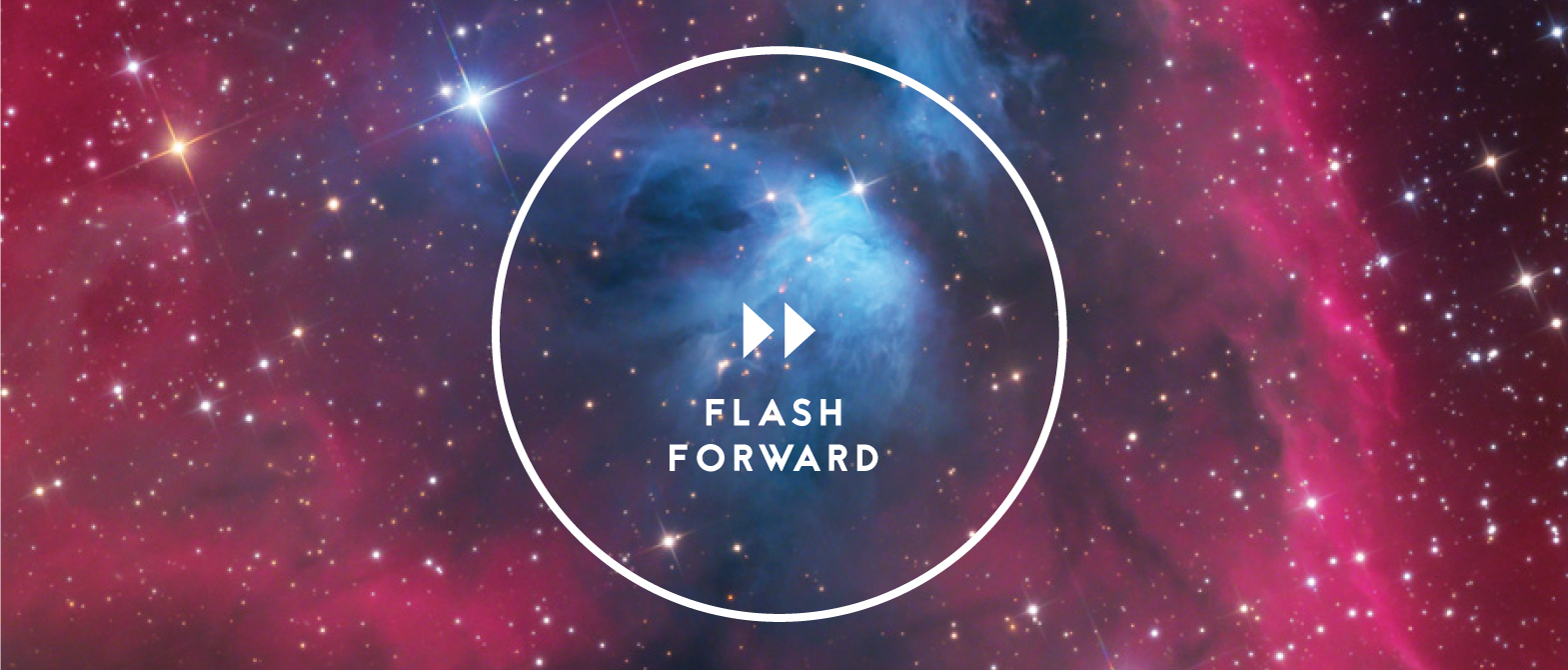
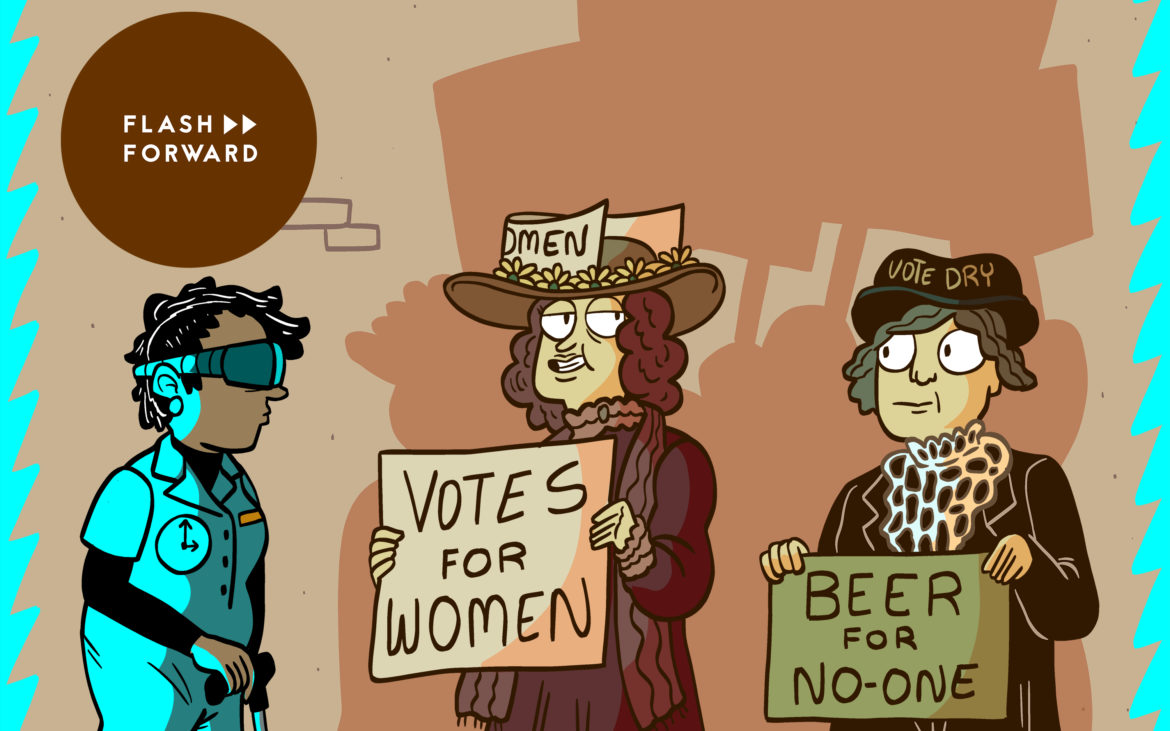
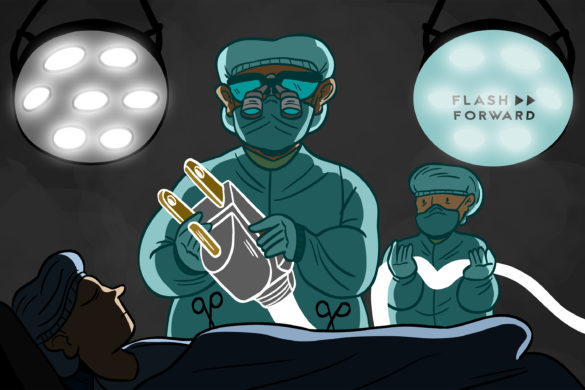
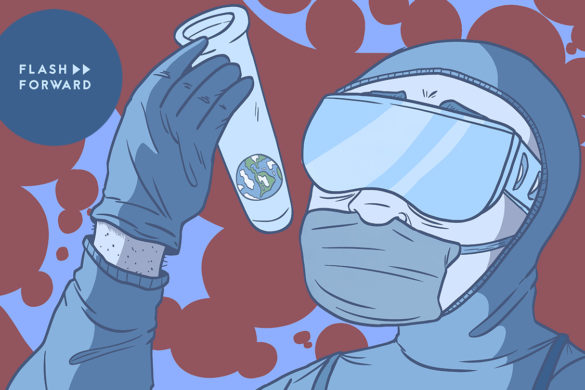
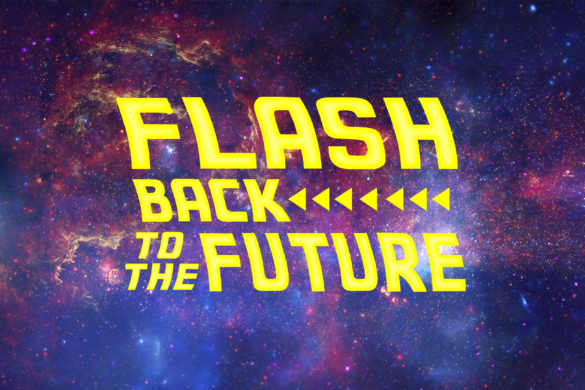
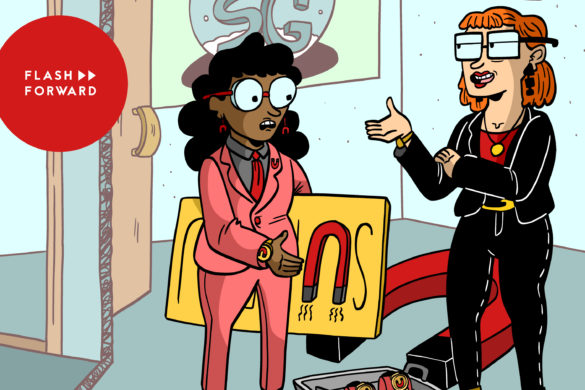
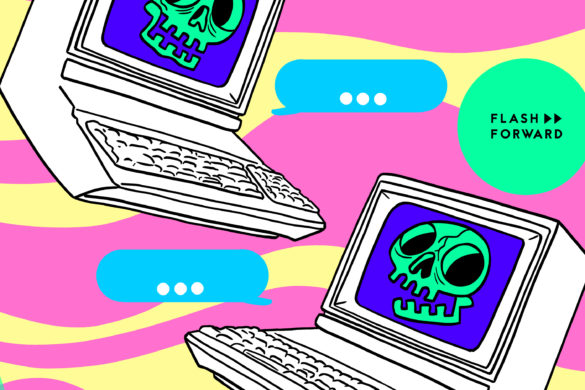
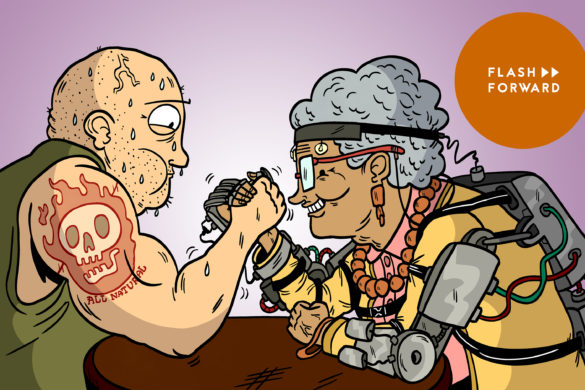
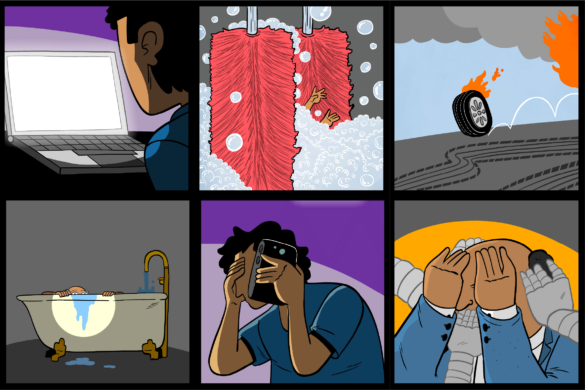
2 comments
[…] POWER: 1919 (Episode 100!) […]
[…] 1920, women were given the right to vote. We covered that on a past episode of the show called […]